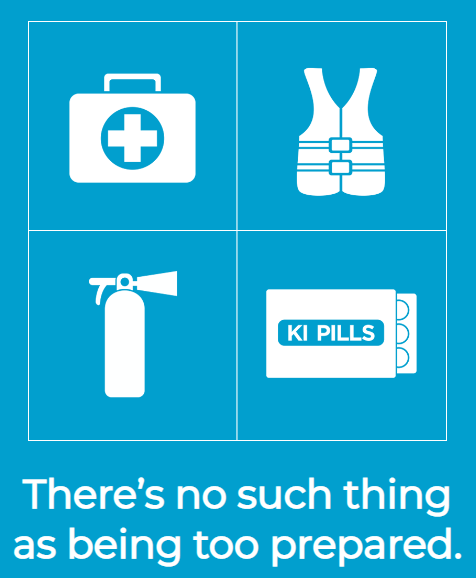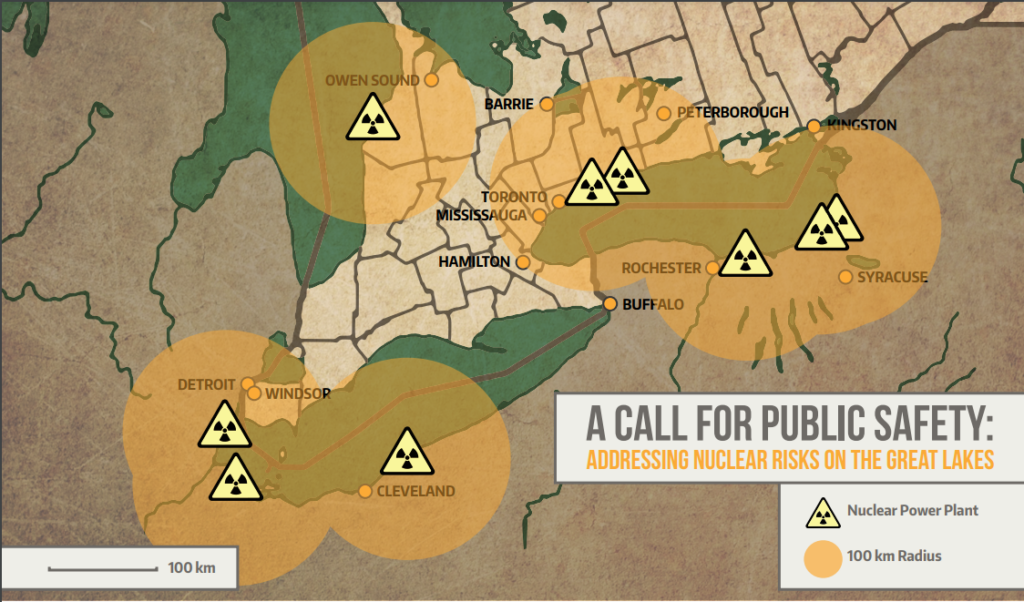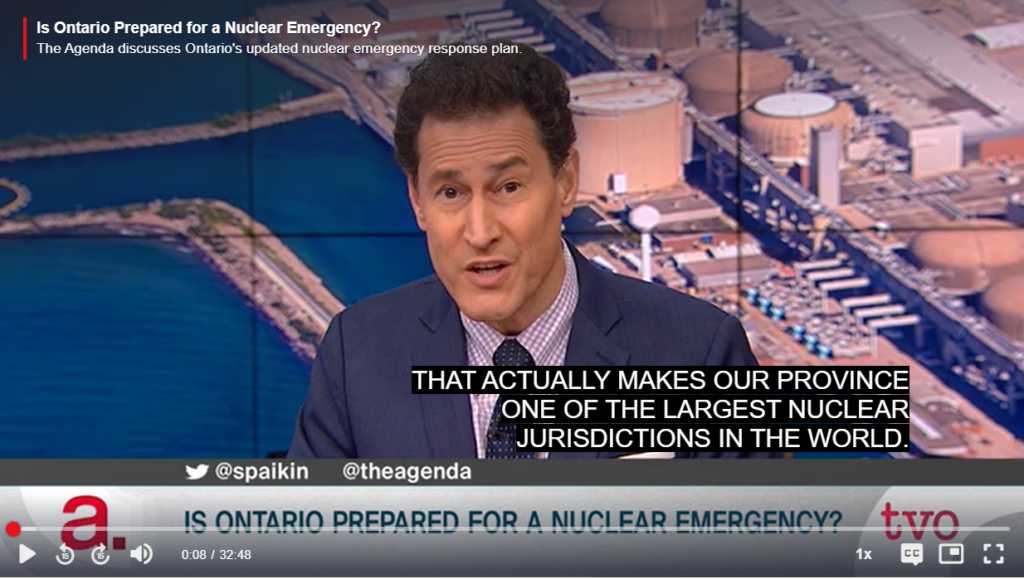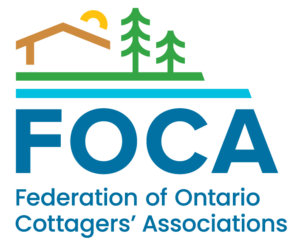
FOCA and other public interest community groups call for a nuclear waste review that is transparent, and independent of the nuclear industry.
In 2021, FOCA was one of over 100 groups who signed a joint letter to the Canadian Prime Minister, setting out expectations for a nuclear waste review. Read the letter here. (Download PDF, 5 pages)

There are nuclear plants located on the shores of the Great Lakes in Canada and the United States.
Eventually, some of these nuclear reactors will be retired. Spent nuclear waste must be managed. Emergency plans must stay updated. Human and watershed health must be protected.
Find out more about Canada’s plans for the long-term management of used nuclear fuel from the Nuclear Waste Management Organization (NWMO) including information related to long term storage, security, transportation, public safety, and emergency management.

June 21, 2022 – Ontario is one step closer to having a deep hole for nuclear waste (TVO) – two sites have made it to the final step in the selection process (one northwest of Ignace and another in South Bruce). Get related information from the NWMO about each of the potential sites, and which additional areas are no longer being considered.
May 16, 2022 – FOCA’s colleagues at the Canadian Environmental Law Association (CELA) submitted a report to the Great Lakes Executive Committee which oversees activities under the Great Lakes Water Quality Agreement (GLWQA): Renomination of Radionuclides as Chemicals of Mutual Concern Under the Great Lakes Water Quality Agreement (PDF, 18 pages). Background: in March 2016, 110 groups including CELA and FOCA submitted an application under the GLWQA to designate radionuclides as Chemicals of Mutual Concern. The new submission restates our ongoing concerns.
 April 19, 2022 – a new report from the International Joint Commission (IJC) Great Lakes Water Quality Board recommends special precautions that governments should take to better protect Great Lakes water quality when it comes time to retire nuclear plants. There are currently 18 nuclear plants located on the shores of the Great Lakes in Canada and the United States. Learn more here and watch a short video summarizing the board’s report, “Decommissioning of Nuclear Power Facilities in the Great Lakes Basin.”
April 19, 2022 – a new report from the International Joint Commission (IJC) Great Lakes Water Quality Board recommends special precautions that governments should take to better protect Great Lakes water quality when it comes time to retire nuclear plants. There are currently 18 nuclear plants located on the shores of the Great Lakes in Canada and the United States. Learn more here and watch a short video summarizing the board’s report, “Decommissioning of Nuclear Power Facilities in the Great Lakes Basin.”

January 18, 2022 – 30,000 shipments of nuclear waste would move through Ontario cities & farmland under draft plan. The NWMO says 5.5 million radioactive spent nuclear fuel rods would come from Ontario, Quebec, Manitoba and New Brunswick by truck or rail to either Ignace or South Bruce in Ontario. (CBC)
August, 2020 – Proposal for permanent disposal of nuclear waste on crown land: The NWMO will begin transporting used nuclear fuel from reactor sites in Canada to a deep geological repository in the 2040s, and is seeking input to guide future plans.
Nuclear Emergency Preparedness:

January 2020 – There’s no such thing as being too prepared in the event of a nuclear accident. Learn more. (PrepareToBeSafe.ca)
Most people in southern Ontario live near an aging nuclear reactor, operating on either the Canadian or American shores of the Great Lakes.
It is important that the Government of Ontario ensures there are nuclear emergency response plans in place to:
- protect people from Fukushima-scale accidents;
- protect vulnerable communities;
- protect drinking water;
- ensure transparency and public participation;
- meet or exceed international best practices.
Learn more about the Provincial Nuclear Emergency Response Plan (PNERP), which was updated in 2017.

In 2017, FOCA and over 40 other public interest organizations expressed concern that gaps in Ontario’s nuclear emergency plans were leaving people vulnerable in the event of a nuclear accident on the Great Lakes. Download the Call for Public Safety (PDF, 8 pages)
In early 2018, TVO produced an episode on the subject of thye PNERP, titled, “Is Ontario Prepared for a Nuclear Emergency?” Click to be taken to the TVO webpage to watch the video recording.


about the plan for a deep geologic repository for nuclear waste in Ontario:
For 40 years, nuclear generation has provided about half of Ontario’s electricity, primarily through Ontario Power Generation (OPG).
Over the past 15 years OPG worked on a plan to store low and intermediate level waste, like products and equipment used in reactor buildings that may have collected some radiation during use. OPG studied and consulted on the creation of a deep geologic repository (DGR) to meet this need, with the intention of implementing a safe, permanent solution to manage nuclear waste. The DGR was proposed to be located at the secure Bruce nuclear site on the shores of Lake Huron.
In June 2020 OPG formally ended its plan for a proposed nuclear waste DGR at Bruce Power (as reported by Blackburn News). Prior to this announcement, FOCA and others had expressed concerned about any adverse effects to human health or the environment, including Lake Huron and the Great Lakes, from the proposed long-term storage of nuclear waste in the subject location, about one kilometre inland from the shore of Lake Huron, and 700 meters below ground, just north of Kincardine, ON. In general, FOCA concurred with the statement of the Canadian Environmental Law Association (CELA), in that:
- Regardless of our respective opinions about the merits of the technology, a common goal must be a strong, reliable, publicly credible regulatory process for this industry and there is major room for improvement in this sphere in Canada’s regulatory system.
- Increased participation rights, transparency, access to information, and ability to probe and test evidence should be improved and made routine, and an aim of all of the regulators and decision makers should be to increase public confidence in the Canadian system.
FOCA also concurred with the motion circulated by Sarnia Mayor Mike Bradley in late 2012, asking the 90 members of the Great Lakes and St. Lawrence Cities Initiative for no low-level waste site to be approved until it’s been debated by “all government bodies including federal, provincial and municipal, and representatives from the United States.”

about nuclear waste management, nuclear emergency preparedness, and earlier DGR news:
Please note: the following is archival material, and some links to third-party resources may no longer be active.
Oct.6, 2021 – U.S. opposition to Canadian government’s nuclear waste storage facility proposal in Great Lakes Basin (Cottage Life)
May 31, 2021 – FOCA’s letter to Natural Resources Canada, in response to Canada’s review of radioactive waste policy.
March 24, 2021 – Ottawa Riverkeeper submission on Nuclear Waste Management in Ontario
May 19, 2020 – Canada Needs a National Radioactive Waste Policy (Canadian Environmental Law Association)
August 2020 – Public Input needed on Draft (nuclear waste) Transportation Planning Framework (Nuclear Waste Management Organization)
February 12, 2020 – The Saugeen Ojibway Nation(SON) has voted “NO” to the proposed Ontario Power Generation (OPG) nuclear repository at the Bruce Power (Inverhuron Committee Newsletter)
February 1, 2020 – Indigenous community votes down proposed nuclear waste bunker near Lake Huron (Canadian Press)
January 20, 2020 – Nuclear Waste Management Ontario – Moving Forward (from the 2020 Rural Ontario Municipal Conference)
~~~
Nov.30, 2017 – A letter signed by 104 Great Lakes Mayors opposing OPG’s proposed nuclear waste repository was sent to Catherine McKenna, Minister of Environment and Climate Change. Download a copy of the letter (PDF, 11 pages)
 The map on this page (click the image to enlarge), provided by “Stop the Great Lakes Nuclear Dump,” shows 230 resolutions passed by US and Canadian municipalities in opposition to the plan, updated to September 2017.
The map on this page (click the image to enlarge), provided by “Stop the Great Lakes Nuclear Dump,” shows 230 resolutions passed by US and Canadian municipalities in opposition to the plan, updated to September 2017.
August 21, 2017 – the Canadian Environmental Assessment Agency reports that the Minister of Environment and Climate Change has requested additional information on the environmental assessment from OPG.
June 27, 2017 – Scientists decry plan for Ontario nuclear-waste site (Globe and Mail)
May 18, 2017 – Ontario nuclear emergency plan inadequate (Global News)
April 1, 2017 – Town divided over plan to store nuclear waste near Lake Huron (CTV – W5 video recording in 2 parts)
March 17, 2017 – Ottawa Riverkeeper studies plans for permanent disposal of radioactive waste beside the Ottawa River
2017 – Canadian Nuclear Laboratories (CNL) has initiated the regulatory approvals process, including a federal environmental assessment, for a proposed Near Surface Disposal Facility (NSDF) for the management of CNL’s low-level radioactive waste. The Canadian Nuclear Safety Commission (CNSC) will make a decision after a licensing hearing in January 2018. A solution for CNL’s “legacy obligations”? According to CNL, the near surface disposal technology has been demonstrated internationally and the location, construction and operation will be subject to a rigorous regulatory process, including environmental assessment. More info… To stay informed on this project, contact CNL at communications@cnl.ca or call 1- 00-364-6989.
January 18, 2017 – the Canadian Environmental Assessment Agency (CEAA) will accept public comment until February 17, 2017 on the most recent information submitted by OPG about the proposed DGR. Click here to link to the CEAA posting.
January 10, 2017 – OPG Report on planned nuclear waste bunker blasted as ‘inadequate.’ (National Newswatch)
January 3, 2017 – OPG submitted 3 additional studies, as requested by the federal Minister of Environment and Climate Change. Visit OPG’s webpage for links to the studies and additional reports.
December 2016: OPG’s response to outstanding questions is expected by year-end. See the September 2016 letter from Minister McKenna (PDF, 1 page) of the federal MOECC on the subject.
June 17, 2016 : New group SOS Great Lakes has formed in opposition to the DGR; rebranded from SOS Saugeen Shores to reflect their objective of building awareness among the 40 million people who rely on the Great Lakes for drinking water. Visit the new website: www.sosgreatlakes.org
April 2016 : Save our Saugeen Shores provides detailed input re: DGR to Minister McKenna
April 15, 2016 : OPG Commits to completing further DGR studies by year-end
Feb.18, 2016: Federal Environment Minister Delays DGR decision date (CTV News)
Jan.20, 2016: Stop the Great Lakes Nuclear Dump, a group opposed to the DGR, delivers petition results to Federal Environment Minister
Nov.30, 2015: Finland moves forward on construction of world’s first permanent repository for spent nuclear fuel. (Corporate Knights)
Sunday, November 29, 2015: DGR decision put off (Owen Sound Sun Times) – See the official notice under the Canadian Environmental Assessment Act, 2012, extending the time limit for the issuance of the Decision Statement for the proposed DGR project, by ninety days.
November 24, 2015: Radioactive waste mounts up as Japanese residents resist post-Fukushima disposal plans (Asahi Shimbun)
Oct.31, 2015: Wasaga Beach residents fighting DGR. Read the Barrie Examiner news post
October 6, 2015: Town Hall Meeting, Toronto Council chambers. Topic: the plan to store nuclear waste deep underground at the Bruce Nuclear site in Kincardine, Ontario, which borders the Great Lakes. Hosted a panel of experts, elected officials and others opposed to the plan.
June 2015 – Canadian Environmental Assessment Agency announced a public comment period on the last phase of the EA process for the proposed DGR. (This will push back the final decision until after Canada’s federal election this fall.) Comment by September 1, 2015. Click here for details.
May 7, 2015 – the Joint Review Panel released their report. Read this May 8, 2015 summary by Ecolog: Environmental assessment endorses nuclear burial plan, including a link to the full 457-page report. Overview: The environmental assessment of Ontario Power Generation’s (OPG) proposal to bury nuclear waste near the shore of Lake Huron concluded that the plan is sound from an environmental and engineering standpoint. The decision whether or not to proceed with the plan now rests with federal Environment Minister Leona Aglukkaq, who has 120 days to make her decision.
Responses to the Joint Review Panel report released in May 2015:
- OPG Values Water – an open letter from Ontario Power Generation CEO Tom Mitchell in support of the DGR
- The group “Stop the Great Lakes Nuclear Dump” responded in opposition to the panel’s conclusion, and continues their petition, here.
- May 21, 2015 – Ontario First Nations demand a say over nuclear waste storage (Globe and Mail)
- May 14, 2015 – Great Lake mayors pan deep-burial nuclear waste option (London Free Press)
- May 12, 2015 – Concern in U.S. over DGR (Owen Sound Sun Times)
November 18, 2014: DGR Joint Review Panel announces close of public comments, with receipt of over 1900 submissions since January 2102. Due to the “numerous significant, complex and technical documents,” the final report from the Panel to the Minister of the Environment will extend beyond the 90 day period, to no later than May 6, 2015. Read the letter from the Panel, here. (pdf; 2 pages)
September 18, 2014: Senators Stabenow, Kirk, Levin and Baldwin introduce resolution 565 in US Senate that Canadian government should not allow a permanent nuclear waste repository to be built within the Great Lakes Basin. Click here to read the Resolution (PDF; 3 pages, courtesy www.stopthegreatlakesnucleardump.com) SR. 565 is a companion resolution to HR. 716 that was recently introduced in the US House of Representatives.
Additional Joint Review Panel public hearings on the proposed Deep Geologic Repository (DGR) for Low and Intermediate Level Radioactive Waste ended September 19th. Review the schedule of presenters and archive of webcast proceedings posted by Canada’s Nuclear Safety Commission, here…
June 2014: Provincial Parties will weigh in on future of Lake Huron nuclear waste burial. This recent article published by CEA and Northwatch is the latest account of where the Ontario Provincial parties stand, and also catalogues the perspectives from interested stakeholders on both sides of the border.
March 25, 2014 – More information about nuclear waste storage needed following an accident at a site in New Mexico. Toronto Star
March 2014 – The Joint Review Panel has announced that more hearings will be held, once the Panel completes its review of responses from Ontario Power Generation, related to the Panel’s additional requests for information from November 2013. Following receipt of these answers and further hearings, the Panel will make its report to the Federal Government, leading to a decision by federal cabinet to approve the plan, or not. Read the Notice to Interested Parties here (pdf; 2 pages).
October 2013: Public hearings ended.
Sept.17, 2013 – David Suzuki speaks against Great Lakes Nuclear Dump. Read the press release… (pdf; 2 pages)
Sept.13, 2013 – read the Toronto Star article, “Kincardine nuclear waste site debate heats up.”
Sept.12, 2013 -read the Globe and Mail article about OPG plan to bury nuclear waste near shores of Lake Huron.
June 2013: Deep Geologic Repository Joint Review Panel (pdf; 14 pages). The deadline to indicate public interest in commenting was July 5, 2013.
May 24, 2013: the Great Lakes and St. Lawrence Cities Initiative, a group of 103 Canadian and US mayors from the region, released a statement in opposition to the Deep Geologic Repository (DGR) proposal for nuclear waste, and the end of the public comment period. Read the release (pdf; 3 pages)…
May 2013: FOCA comments on Nuclear Waste storage on the Great Lakes – FOCA is concerned about any adverse effects to human health or the environment, including Lake Huron and the Great Lakes, from the proposed long-term storage of nuclear waste about 1 km inland from the shore of Lake Huron, and 700 meters below ground, just north of Kincardine, ON. FOCA responded to OPG’s call for Public Comments until May 24/13; read FOCA’s comments (pdf; 1 page). Also read the submission (pdf; 62 pages) from the organization called Stop The Great Lakes Nuclear Dump.
